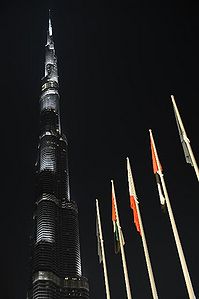Communication and Media Richness Assurance in High-performance Projects
Case Studies
Having studied a selection of commonly used communication media, a look at how project communication in industry affects project success/failure may be interesting. In the following section three case studies are compared and contrasted in terms of their final delivery outcome and the impact in-project communication has had thereupon. The case studies have been selected based on shared project similarities and their varying degree of project communication success, ranging respectively from poor through adequate to good.
Burj Khalifa

Burj Khalifa was opened at the heart of Dubai in 2010, stands 828 metres tall and claims the official title as the World's tallest building[1]. At a cost of USD $1.5 billion, constructed by approx. 12,000 labourers[2] and projected to have huge returns-on-investment for Dubai later cemented in popularity rankings [3], the building is the epitome of a mega project[4].
On the day of the opening, at the opening ceremony, the building changed its name. Dubai's ruler, Sheikh Mohammed bin Rashid al-Maktoum, renamed the former Burj Dubai in honour and recognition of the national leader, Sheikh Khalifa bin Zayed bin Sultan al-Nahyan[5]. Beneath the public domain surface, the appearingly sudden name change was rooted in a sizeable financial bail-out of Dubai, including this project, by the UAE ruler as a result of Dubai's weakened economy owing to the global market downturn of 2008-09[6].
"The change caught everyone off guard, from news organisations, including the BBC, which hours later were still using a name that no longer existed; to the Roads and Transport Authority, which suddenly had to rename the tower's newly opened Metro station and replace dozens of road signs. But while many were stunned by the name change, one group was also facing an economic shock: the souvenir sellers...The tower's official store at the observatory on the 124th floor was still selling goods with the old name"[7].
Sheikh Mohammed bin Rashid al-Maktoum provides his own overall economic and infrastructural vision in his book, which includes the statement "providing grassroots opportunity and a better quality of life for the people of this region is guaranteed to ameliorate our shared problems of instability and conflict. We have a critical need for long-term projects and initiatives to eliminate poverty, improve education and health, build infrastructure, and create economic opportunities."[8]
The communication througout this project could be summarised by listing a few key decisions made:
- Sheikh Mohammed bin Rashid al-Maktoum accepts financial help from the national government to (amongst other financial commitment) keep the project on track
- Sheikh Mohammed bin Rashid al-Maktoum times the building name-change for the opening ceremony
- External companies en mass, alongside some internal building stakeholders, had to make urgent arrangements to minimise losses in connection with the situation
The situation could be considered critical: A construction project worth...
4 January 2010
A six-year construction period commencing in 2004
Key points: On time? on budget? fully functional/operational as intended?
Project assessment: Success
(This section is unfinished and will be expanded)
The
Key Points: The higher the risk, the more important communication becomes Action speaks louder than words (get away with errors in verbal communication, as non-verbal communication through action is more important) Transparency, openness and honesty in project management usually provide better results than hidden agendas and unaired/undebated problems.
References
- ↑ 1.0 1.1 burjkhalifa.ae. Burj Khalifa: Facts & Figures, [Online], Available at: https://www.burjkhalifa.ae/en/the-tower/facts-figures/ [First accessed 26 February 2019]
- ↑ John Irish (2010). Burj Dubai cost $1.5bn to build, [Online], Available at: https://www.arabianbusiness.com/burj-dubai-cost-1-5bn-build-27430.htm [First accessed 1 March 2019]
- ↑ Karmila Thomas (2018). Dubai’s Burj Khalifa ranked among world’s top 10 most popular destinations, [Online], Available at: https://gulfbusiness.com/dubais-burj-khalifa-ranked-among-worlds-top-10-popular-destinations/ [First accessed 1 March 2019]
- ↑ Bent Flyvbjerg (2014). What you should know about megaprojects and why - an overview, [Online], Available at: https://www.pmi.org/learning/library/know-mega-projects-overview-2267 [First accessed 1 March 2019]
- ↑ Hugh Tomlinson, David Robertson (2010). Dubai's humiliating name-change for world's tallest building, [Online], Available at: https://www.theaustralian.com.au/news/world/dubais-humiliating-name-change-for-worlds-tallest-building/news-story/28a71fd99417acacec0f5f47bb9cc339?sv=735ed5a745678ed310b1ac3d19263b27 [First accessed 1 March 2019]
- ↑ Ben Thompson (2009). Abu Dhabi gives Dubai $10bn to help pay debts, [Online], Available at: http://news.bbc.co.uk/2/hi/business/8411215.stm [First accessed 1 March 2019]
- ↑ Tahira Yaqoob (2010). Nice souvenir, shame about the name, [Online], Available at: https://www.thenational.ae/uae/nice-souvenir-shame-about-the-name-1.543049 [First accessed 1 March 2019]
- ↑ Tahira Yaqoob (2010). Flashes of Thought, [Online], Available at: https://www.thenational.ae/uae/nice-souvenir-shame-about-the-name-1.543049 [First accessed 1 March 2019]